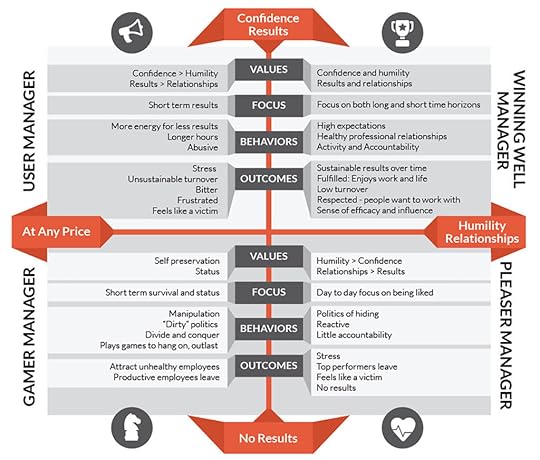David Dye's Blog, page 116
February 10, 2017
4 Questions to Ask Yourself and Your Team to Stay Focused on the Most Important Thing

The Overwhelm Is Real
I hear it all the time: “I’m overwhelmed. I can’t possibly do everything on my plate. What should I do?”
I’ve never met a manager who has enough time to do everything they want to do. A longer to-do list than you can possibly achieve comes with the territory.
Recently, I found myself there as well. An endless list of awesome possibilities confronted me, but I wasn’t showing up the way I wanted to for any of them: not for my relationships, not for my volunteering, and not for my business.
The stress that comes with being ‘too busy’ is inescapable – or is it?
Two Realities You’ll Never Escape
With a quick change in perspective, you can end the stress of to-do overwhelm. There are many time and priority management systems available, but they all come down to these two principles:
1) There will always be more to do than you can possibly get done.
This is a fact of life. If you tried, you could easily list 100 things you can do right this moment. The only difference when you’re feeling overwhelmed is your awareness. You perceive many of those options vying for your attention.
It’s true that you may have more on your to-do list, than you can possibly do. (In fact, if you’re a competent, caring person, you undoubtedly have more great options than you can possibly do.) Welcome to life.
2) You only have one choice: What one thing will I do right now?
You can only truly focus on one task at a time, so what will it be? We call this one task the M.I.T. – the most important thing.
What is most important?
To help you and your team stay focused on the M.I.T., try this activity:
M.I.N.D the MIT
What Matters most?
What results must we achieve if we’re to succeed?
What values have we committed to? (if you’ve completed your Winning Well Manifesto, look here.)
When we walk away from our work, what will we be proud we accomplished?
Win or lose, how will we know we’ve done our very best?
Which actions have the most Impact?
What are the critical behaviors that drive your results?
If we could only do one thing, which behavior would have the greatest impact?
What invisible behaviors might we forget? (eg: sleep, time with others, fun)
Where Do I / we need to say No?
What are we choosing to do instead of our MIT?
How can we make a different choice?
What are silly, creative, impossible ways to do things differently?
Where do we need to have tough conversations?
How Will I/we stay Disciplined?
What are my/our biggest distractions?
How can we ensure they don’t derail us?
How will we keep the MIT in front of us all the time?
How will we hold ourselves accountable for maintaining focus on the MIT?
Your Turn
For me, the critical question I needed to ask was the “N” question: where did I need to say no? I had overcommitted to many wonderful opportunities, but if I was going to be effective, I had to make a decision. In the end, I chose not to participate in a prestigious volunteer opportunity that was also a way for me to give back to people who have made a difference in my life and career. It was a hard decision because it was a fantastic opportunity. But in order to say yes to the best things in your life, you’ll need to say no to the ‘pretty good’.
What is your M.I.T. for this week? Your M.I.T. for today?
How will you say no to say yes to your M.I.T.s?
(It’s okay – you can do it. You have my permission 
February 5, 2017
5 Top Leadership Articles for the Week of February 6, 2017
Get the help you need right away – one week left to register: Get an hour of personalized coaching with me and our best seller: a month of my daily video leadership inspiration at more than 75% off. Get more information here.
Each week I read a number of leadership articles from various online resources and share them across social media. Here are the five leadership articles readers found most valuable last week. I have added my comment about each article and would like to hear what you think, too.
There is One Quality That Builds Trust and Loyalty by Renuka Rayasam
About two years ago, when Pink Jeep Tours decided to expand, it investigated exactly what set it apart from the competition and in which areas it could improve. The 57-year-old Arizona-based company, which offers sightseeing excursions around the Grand Canyon, Sedona and Las Vegas in bright pink jeeps, had set its sights on growth throughout the US and new markets abroad.
They are real charmers. So the company’s management measured its net promoter score, which gauges customer loyalty and happiness. Pink Jeep found that it wasn’t just its eponymous vehicle colour that helped it score 91 out of 100 on the customer loyalty scale. It was the company’s guides, who must complete 150 hours of training before giving a tour, that were the key in keeping customers happy and keen to return. Some of the guides are so warm and friendly that customers want to keep in touch with them after their excursions have ended
My Comment: If you pay attention to human relationships, it should come as no surprise that warmth is the differentiator between who we trust and are loyal to. Faked warmth grates on us and drives us away. In contrast, when someone demonstrates genuine concern and has your best interests at heart, it’s much more likely you’ll trust them. Do you lead that way? Can your people honestly say you care about them and want what’s best for them? If so, you’re on your way to being the leader you want your boss to be.
This Seven-Step Guide for Dishing Out Feedback is Totally Idiot-Proof by Karin Hurt and David Dye at Fast Company
Giving critical feedback isn’t easy, especially if you’re new at it. But it doesn’t need to be half as hard as many managers think. The main thing is to keep it short and specific. Every good feedback conversation has to accomplish three goals:
Draw attention to the issue
Create a two-way dialogue about it
Inspire and confirm the commitment to new behavior
How do you do all that as efficiently as possible, without leading to hurt feelings? These seven steps can help you map out a script, no matter how sticky the situation or unfamiliar the experience.
My Comment: This article is adapted from our book, Winning Well: A Manager’s Guide to Getting Results Without Losing Your Soul. When I promote someone into a leadership role, after a foundation of character and competency, the first leadership skill I look for is the ability to have tough conversations. If you’re serious about leading, master the art of the tough conversation (and ditch the diaper drama – sandwich feedback).
Want to Increase Employee Engagement? Hold Managers Accountable by Natalie Hackbart
The best organizations know that engaged, high-performing employees drive business success. Engaged employees are more productive, more profitable, more customer-focused, and more likely to stay. And highly engaged workplaces grow faster, adapt quicker, and innovate more. It’s no wonder that Quantum Workplace’s State of Employee Feedback report found that almost 37 percent of organizations said increasing employee engagement was their top people priority this year.
But how can we make improvements on a metric that has been declining the past three years? Organizations working to increase employee engagement have a powerful key at their disposal: manager accountability.
My Comment: The concept of manager accountability is valid, but generic. The meat here is in the specific suggestions Hackbart recommends managers be held accountable for doing. I think it’s important to remember that employee engagement is a product of effective leadership. If you put your focus on managing an employee engagement score, you’ll inevitably get people gaming the score, not playing the game.
The Top Three Factors Driving Employee Burnout by Joyce Maroney
Imagine a problem affecting 95 percent of all businesses. A universal problem, so pervasive, that nearly every organization is feeling the pinch. With so many diverse industries, it’s almost hard to fathom. But a crisis that’s been percolating in the American workforce for years has now reached epidemic proportion. You’ve probably heard of it, too: employee burnout.
According to the study in the Employee Engagement Series conducted by Kronos Incorporated and Future Workplace, 95 percent of human resource leaders say that employee burnout is sabotaging their workforce. It’s not just a few folks feeling overworked or run down either. The study – which included more than 600 Chief Human Resource Officers, VPs of HR, HR directors, and HR managers from organizations of all sizes – found that nearly half of HR leaders attribute up to half of their employee turnover to employee burnout.
My Comment: Burnout comes down to a couple of issues. First, disassociating the human beings from the work they do. People aren’t machines, nor are they numbers. With many management and decision-making processes, it is too easy to forget the people behind the decisions you make. Second, burnout often results when a person isn’t a good match for their role or is inadequately trained and equipped to succeed. The third reason I’ve seen is that some organizations use burnout as part of their “talent strategy. They intentionally overwork people until they move on, then replace them. It’s a User Manager approach that is inefficient. Maroney addresses these and other reasons people experience burnout and encourages you to take steps to prevent it.
Ten Unmistakable Signs of a Bad Place to Work by Liz Ryan
Dear Liz,
I’ve had three interviews with one company and they’ve just offered me the job. I’ve worked really hard to get to this point. After the first interview, they went silent.
They stopped communicating. To be honest, it was very impolite of them to interview me and then just forget about me. They didn’t return my phone calls or email messages.
A month later I heard from them. They wanted me to come back for a second interview…
My Comment: This is a fun list and one to which I’m sure we could all add a few items. The value for you as a leader: do any of these apply to you? If so, take a look at yourself, your processes, and your personnel.

David works with leaders to get results without losing their soul (or mind) in the process. Have David keynote your next event or deliver corporate training: Email today or call 303.898.7018!
The post 5 Top Leadership Articles for the Week of February 6, 2017 appeared first on Leadership Speaker David Dye.
Book David today for your event, workshop, or training: david@trailblazeinc.com or 1.800.972.582
January 29, 2017
5 Top Leadership Articles for the Week of January 30, 2017
 Don’t Miss Out: If you’ve been putting it off, the fantastic Amazon promotion ends tomorrow…just 2.99 for the Kindle version. Get one for everyone on your team.
Don’t Miss Out: If you’ve been putting it off, the fantastic Amazon promotion ends tomorrow…just 2.99 for the Kindle version. Get one for everyone on your team.
Each week I read a number of leadership articles from various online resources and share them across social media. Here are the five leadership articles readers found most valuable last week. I have added my comment about each article and would like to hear what you think, too.
How to Accept Imperfections Like a Leader by Dan Rockwell
If I could begin my leadership journey again, I’d accept imperfection. Leadership begins after you accept imperfection. If I could take back the time I wasted on searching for perfection – before I took action – I’d be young again. More important, I’d have wisdom from learning as I go, not before I go.
The right answer is the one that’s good enough to create imperfect progress. Get going.
My Comment: Rockwell’s words really hit home for me. How much time do we waste trying to get things perfect, rather than connect with people, take action, and be bold. If you’re like me, Rockwell, and other leaders who have struggled to take action for fear of making mistakes – you have an opportunity for yourself and the people you lead. He encourages us to “confront mistakes of negligence” but to celebrate “mistakes of initiative.”
I had one of the latter this week. I made a mistake because I was moving quickly and wanted to take action, rather than wait. It didn’t work out the way I would have liked – but I did learn from it and eventually allowed myself to celebrate the fact that I’d taken action. What ‘mistakes of initiative’ can you risk this week?
Stop This Terrible Habit You Don’t Even Know You Have by Karin Hurt at Lets Grow Leaders
How do I know you have it? Because I have it too. Most high-performers do.
It’s a sneaky little bugger, because on the surface it really feels like you’re doing the right thing. And on most levels you are. It’s a Winning Well core competency taken to extremes.
But if you go too far, the stress will crush your spirit and undermine your confidence. It’s one more way great managers lose their soul.
In an effort to know your vulnerabilities, to admit mistakes, to always look for ways to improve… it’s so easy to beat yourself up.
My Comment: This article by my Winning Well co-author was very popular this week and is a great follow-up to Rockwell’s invitation to be imperfect.
When you lead, you’re going to make mistakes. Beating yourself up doesn’t serve you. In fact, it keeps you from doing the very things that make you effective and, even worse, allows the people who don’t have a conscience to speed past you. Hurt invites you to “treat yourself with the same level of compassion as you would offer to your team, your boss, or the people you love.” Once again, that’s wisdom I regularly need to hear!
The Dying Employee Engagement Survey: New Ways to Measure Engagement by O.C. Tanner
Everybody’s worried about employee engagement, and for good reason. Employees can go to work every day, but if they aren’t truly engaged in the work, they’re simply wasting your company’s valuable assets. Today many organisations struggle with something called “presenteeism” meaning that employees are present at work, but not productive. According to Carnegie Management, “Current research shows this to be a $33 billion loss to Australian industry.” And a recent survey by Aon Hewitt showed only a 65% engagement rate among employees of the Asia Pacific region. So with so many employees present, but not productive, what is to be done?
My Comment: I’ve long maintained that most employee engagement surveys are a waste of time. They can do more harm than good if you’re not prepared to really listen and respond – no matter what the results might be. Tanner takes a look at this and other issues that plague these surveys before offering other ways to look at engagement.
(A quick aside here: engagement IS important. But engagement is a product of you leading well. When you look at it as an end in-and-of-itself, you risk gaming the score, not playing the real game.)
An Unparalleled Perspective of the Innovative Future of Work by Valerie Martinelli at Careers In Government
Businesses typically spend much of their time and efforts around the customer experience. After all, it is the consumers that drive our businesses and keep us going, right? However, it is our employees that drive our consumer experience and ensure that they are receiving the best experience possible. Coincidently, HR is now looking to the employee experience as the future of work. There is a direct correlation between employee engagement and success in consumer experience because companies with highly engaged workforces outperform their peers.
My Comment: Once again, the vital nature of an employee’s experience is highlighted. The bottom line here is that if you want more productive employees, take a look through their eyes. What helps them (not a manager’s version of them) actually release their talents, energy, and creativity toward their work. What gets in their way? How can you help with more of the first and less of the second? It’s not hard…but it is hard work. That’s leadership.
Management Tip: Building a Winning Workplace Culture by Magi Graziano
The number one driver of employee engagement and workplace performance is culture, so why do so many companies fail at establishing one that wins?
When your workplace culture is working, it is something that the senior leadership propagates and leverages as a competitive advantage. However, when your company culture is not functioning properly — or not working at all — it becomes a deterrent to productivity, innovation and employee morale.
Being that the culture you construct at work is one of the most pivotal cogs driving the success of your business, why, then, do so many companies fail at building one that wins? It’s because, frankly, many business owners, managers and CEOs are unaware as to how big of an impact culture really makes. So how do you build a culture that wins? It begins with you, as a leader — you must become the…
My Comment: I was asked this week what role leaders play in creating the culture in their teams and organizations. At first I thought the person asking was being funny – but they weren’t. They were seriously wondering if it were something they could impact as a leader, or if it ‘just was.’ My goodness – we have some work to do! Yes, absolutely – you have a tremendous impact on the culture within the team, department, or company you lead. And your group can impact the larger culture as well (though this is admittedly more challenging and often takes longer). Graziano shares six practical steps you can take to foster a positive culture that cultivates energized, engaged employees.

David works with leaders to get results without losing their soul (or mind) in the process. Have David keynote your next event or deliver corporate training: Email today or call 303.898.7018!
The post 5 Top Leadership Articles for the Week of January 30, 2017 appeared first on Leadership Speaker David Dye.
Book David today for your event, workshop, or training: david@trailblazeinc.com or 1.800.972.582
January 22, 2017
5 Top Leadership Articles for the Week of January 23, 2017
I’m so excited to share that Winning Well was the number one book on this list of 7 Books Every manager Should Read in 2017. If you don’t have yours yet, Amazon is running a fantastic promotion…just 2.99 for the Kindle version.
Each week I read a number of leadership articles from various online resources and share them across social media. Here are the five (plus one more bonus) articles readers found most valuable last week. I have added my comment about each article and would like to hear what you think, too.
The Secret Ingredient for Extraordinary Leadership by Jane Perdue at Lead Change Group
Do you (or your organization) use the vending machine approach to leadership?
That approach is when someone asks the boss a question (inserting the coins) and out pops (like the candy bar, soda, or bag of chips) the correct answer.
This “all-knowing” expectation is common in many organizations: you, as a leader, are rewarded for looking smart by quickly providing answers. Because what gets rewarded gets done, you adjust your actions to fit the preferred mold.
My Comment: Until they learn a different way, most managers fall into the vending machine tendency Perdue describes. Unfortunately, when you always give them a ready answer, the learn quickly that you will willingly do their thinking for them. Soon, you have no time to do your own work as you have a parade of people waiting on you for answers. Worse, they never develop the critical thinking and problem solving skills they need (and that you want them to have). Perdue gives you sound ideas to avoid this mindset and foster your own curiosity. We share more on how to coach your employees, develop their critical thinking, and build a loyal team of problem solvers in chapter 14 of Winning Well.
7 Strategies for Employee Engagement by Toby Savill
Motivating and engaging the people who work for you shouldn’t require bundles of policies and procedures. All it really takes is the willingness to do things differently, communicate better and be more collaborative.
Here are our 7 top strategies all of them low-cost and easy to start implementing today that can help you engage your people and improve your working environment.
My Comment: Sometimes I’m concerned about the employee engagement fad. Too often, I see managers and executives focus on their employee engagement score, rather than the behaviors that actually engage employees. When it comes to engagement, remember that it is a product of healthy leadership – not an end to seek on its own. As we say in Winning Well: play the game, don’t game the score. Savill’s suggested strategies are a great place to start.
Why Real Leaders Have Strong Egos (And That’s a Good Thing) by S. Chris Edmonds at Fast Company
Ego tends to get a bad rap in leadership circles, and it’s no wonder why. When somebody is said to “have an ego,” it’s typically meant that they’re arrogant, condescending, or self-absorbed. The best leaders are popularly cast as humble servants, visionaries who’ve managed to shrink their egos to make room for other people, ideas, and ways of doing things.
Executives are routinely coached to turn away from ego altogether. They’re led to believe their egos will only get in the way of their credibility and effectiveness, and spell certain doom for their ability to forge a purposeful, positive, productive work culture.
Nothing could be further from the truth.
My Comment: Edmonds does leaders everywhere a great service by disentangling the difference between healthy ego and its darker counterparts. In short: you need the awareness, pride, and productivity that a healthy ego brings you. Unfortunately, in our language, the notions of ego-mania and narcissism muddy these conversations. Even the definition of ‘pride’ in the dictionary has two conflicting meanings. Edmonds takes the argument for healthy ego a step farther, suggesting that your team and organization also have collective egos. Healthy leaders are aware of both their own and their organization’s egos and work to support them both.
The Challenge with Motivation by Steve Rizzo at C-Suite Network
One of the biggest challenges that people in business and in life face today is keeping themselves motivated to be at their best. I believe the challenge lies not just in knowing how to get motivated, but how to stay motivated and optimistic to be at their best for more than just a few days.
Most companies put a great deal of time and energy in hiring people who they believe are qualified to fill a particular position. But there is no guarantee that even a highly qualified person will always be motivated to be at their best. It simply means they have what it takes to get the job done.
My Comment: Rizzo takes a fun look through the lens of circumstances that interfere with motivation. He encourages you to be aware of these causes so that you can do something about them. Fair warning: the ‘what to do about them’ are left for his new book: Motivate This!
As I share with every audience, every client, and every leader I meet: you cannot motivate people. People’s motivation, as with yours, comes from within. Your job is to cultivate an environment that releases people’s energy, strength, and talents toward the mission. You can do the same for yourself as well. (In fact, taking responsibility for your own motivation this way is a foundational leadership characteristic.)
The One Characteristic That Makes You a Great Leader by LaRae Quy at SmartBrief
The FBI spends a great deal of time, effort, and money in training agents to be great leaders because agents need to be able to land on their feet when confronted with the unknown.
They also need to know how to get people to trust them with their lives, persevere when challenged with adversity and always come out on the right end of a terrorism case. Great leaders understand how to keep moving forward when roadblocks threaten their success.
The one characteristic that makes FBI agents great leaders is honesty. Lack of candor will get an agent fired quicker than any other mistake or transgression.
My Comment: Don’t let the simplicity of the word ‘honesty’ fool you into complacency. Quy takes a deeper look at what real honesty looks like for leaders. How often and how readily do you own your mistakes? How conscientious are you? Do you cultivate the Winning Well values of humility and confidence in yourself? These are the hallmarks of an honest, and truly trusted, leader.

David works with leaders to get results without losing their soul (or mind) in the process. Have David keynote your next event or deliver corporate training: Email today or call 303.898.7018!
The post 5 Top Leadership Articles for the Week of January 23, 2017 appeared first on Leadership Speaker David Dye.
Book David today for your event, workshop, or training: david@trailblazeinc.com or 1.800.972.582
January 15, 2017
5 Top Leadership Articles for the Week of January 16, 2017
 Amazon is running an incredible special on Winning Well right now – for $2.99 you can get one for everyone on your team and get started achieving breakthrough results in 2017. Get yours today (And if you already have yours – please consider leaving a review on Amazon and help tell the world about Winning Well!)
Amazon is running an incredible special on Winning Well right now – for $2.99 you can get one for everyone on your team and get started achieving breakthrough results in 2017. Get yours today (And if you already have yours – please consider leaving a review on Amazon and help tell the world about Winning Well!)
Each week I read a number of leadership articles from various online resources and share them across social media. Here are the five (plus one more) articles readers found most valuable last week. I have added my comment about each article and would like to hear what you think, too.
How to Improve Trust With One Word by Mary Schaefer at Lead Change Group
If you have ever visited a new doctor, dentist or other medical professional, you might find yourself in the exam room wondering:
Will they respect me or talk down to me? Will we have enough time or will they seem hurried? Will we have the same values?
I’m thinking about a recent experience. I realize now my underlying question is, “Am I going to be treated like a human being or just another case in a folder?” Trust in being seen and heard is paramount for a strong, collaborative relationship.
My Comment: As a leader, your most important asset is your credibility. Can your people trust your competence? Can they trust your motivations? Through a recent experience, Schaefer discusses the vital role of empathy in maintaining trust with your team. It doesn’t take a huge degree of skill – one word, or a few, sincerely said, will make all the difference.
How to Give Feedback that Builds Trust in a Relationship by Randy Conley
Giving feedback to someone is a “moment of trust” – an opportunity to either build or erode trust in the relationship. If you deliver the feedback with competence and care, the level of trust in your relationship can leap forward. Fumble the opportunity and you can expect to lose trust and confidence in your leadership.
My Comment: I echo Conley’s assertion in this article that people not only need feedback, they deserve it. They’re trying. They can’t possibly know what they’re doing well and what needs improvement without feedback from you. Conley offers a great set of guidelines you can use to be more effective with your feedback and build trust. To go deeper and give feedback that leads to improved performance, use the INSPIRE model in Winning Well.
9 Ways to Motivate Employees When You Don’t Set the Goals
This article of mine was the most popular one I shared this week.
Whether you are a team leader, a mid-manager, or even the President, CEO, or Executive Director there will be times in your career where you are asked to meet goals that you did not speak into or, in some cases, even disagree with.
As Julia noted, people often react negatively when they have goals ‘shoved down their throats’ – goals that may have been set by people who may not have all the facts and didn’t ask for input.
The good news is that you and your team can still thrive in these situations – there are ways to motivate your employees when you don’t set the goals.
How to Reduce Employee Turnover With 7 Critical Leadership Skills by Annabelle Smythe at Lead Change Group
Poor leadership is often at the root of high employee turnover.
In fact, according to a recent CMOE infographic, nearly 50 percent of employees were likely to leave their jobs if they didn’t feel recognized by their managers.
While these types of statistics are disheartening, they also reveal an opportunity that the best leaders take advantage of. Developing specific leadership skills for the workplace can support employee retention by increasing performance, job satisfaction and a whole host of other factors.
My Comment: The connection between an employee’s immediate supervisor and their level of engagement is well-established. It’s one thing to understand it, but a much more difficult task to look in the mirror and honestly assess how you are leading and if you’re providing what your team needs to be energized and productive. Smythe gives you a good list of what to do to improve your employees’ engagement. The tough part is knowing how to do it (which is one of the reasons we wrote Winning Well – intuitively you probably know most of these things are important. Knowing how to do them, however, is a challenge for most managers.
Leadership 101: Narrow Your Say-Do Gap by George Deeb at Entrepreneur
I was recently in a client’s office, and they had an interesting collage of words and images hung on their wall, trying to summarize the culture they wanted to create for their employees. One section stood out to me. It said “Narrow your say-do gap” next to the word “Commitment.” I thought it was a great way for the client to manage their team’s expectations. And it must be working. The company has a love affair with their leadership team, evidenced by their employees long tenure with the company and the very high reviews of their CEO on Glassdoor. There are some juicy nuggets in here — something we can all learn as we try to be good leaders with a narrow say-do gap.
My Comment: There’s quite a bit of focus on trust and credibility in the popular articles this week. Deeb’s emphasis on the ‘say-do’ gap is so important. You’ve certainly heard that actions speak louder than words. What do your actions say? Do they reinforce what comes out of your mouth and make you a leader people can depend on? Or do they undermine everything you say until no one can trust you. Many Gamers and Pleasers get caught in a ‘say-do’ gap. If this is you, say less and do more. You won’t offend people by not promising them moon. Say yes only to what you absolutely can do. Build your credibly one kept promise at a time.
Rigid Workplace Cultures Are Holding People Back by Business Matters
The research identified a clear mismatch between employees’ desire for independence and flexibility, and the reality of their current working environments.
Almost three quarters of UK employees say they would like more freedom at work, with more than a third saying they work in a regulated and controlled structure. When asked how they’d like to change their company culture, the top answer was more freedom and flexibility followed by more innovation and creativity.
“Rigid structures, siloed working and overly complex hierarchies are things of the workplace past,” says John Yates, Group Director at ILM.
My Comment: Though this study took place in the UK, many workplaces suffer from the same problem. Employees who are closer to the service or product than anyone else have insights that can enhance customer service and product quality. Too often, however, these insights are stifled in layers of bureaucracy or by managers who feel that they have to control everything to ensure results. We encourage you to ‘trust the trenches’ – get to know the people closest to your customers and projects. Listen to what they have to say.

David works with leaders to get results without losing their soul (or mind) in the process. Have David keynote your next event or deliver corporate training: Email today or call 303.898.7018!
The post 5 Top Leadership Articles for the Week of January 16, 2017 appeared first on Leadership Speaker David Dye.
Book David today for your event, workshop, or training: david@trailblazeinc.com or 1.800.972.582
January 11, 2017
9 Ways to Motivate Employees When You Don’t Set the Goals
 Amazon is running an incredible special on Winning Well right now – for $2.99 you can get one for everyone on your team and get started achieving breakthrough results in 2017. Get yours today!
Amazon is running an incredible special on Winning Well right now – for $2.99 you can get one for everyone on your team and get started achieving breakthrough results in 2017. Get yours today!
What Now?
Julia slammed her laptop shut and slumped over her desk.
“Ugh! What are they thinking? My team’s gonna hate this!”
We had just sat down to discuss her goals when the email arrived from her regional manager. The email listed sales goals she and her team were expected to meet…goals from headquarters that neither she nor her team had any input into.
What Would You Do?
Whether you are a team leader, a mid-manager, or even the President, CEO, or Executive Director there will be times in your career where you are asked to meet goals that you did not speak into or, in some cases, even disagree with.
As Julia noted, people often react negatively when they have goals ‘shoved down their throats’ – goals that may have been set by people who may not have all the facts and didn’t ask for input.
The good news is that you and your team can still thrive in these situations – there are ways to motivate your employees when you don’t set the goals.
9 Ways to Motivate Employees When You Don’t Set the Goals
Remember that you don’t actually motivate anyone.
I’ve written about this elsewhere, but the key idea is that your responsibility is to create conditions that allow employees to thrive. The first step in motivating employees is to remember that you can’t actually motivate anyone.
Take Responsibility – Don’t Pass the Buck
Let’s begin with what NOT to do.
In these situations, the very worst thing you can possibly do is walk into your team meeting and say, “Those clueless jerks gave us these goals and I guess we’re stuck with them.”
These kind of statements are leadership suicide.
They kill your credibility, disempower you and your team, and make your team wonder who they should be talking to, if not you.
Even if you’re not fond of the goals, as the team leader, you’ve signed up to take responsibility and do everything you can to help the organization and your team succeed.
Do not shirk this responsibility. Own it.
Be Transparent
While you don’t want to act like a victim nor encourage victim-thinking in your team, it is also okay to acknowledge the situation.
Your goal is to limit blame and fault-finding, but be up front about where things are.
If the goals are difficult, say so. Remember, the most important currency you have with your team is their trust.
If the team is clearly feeling that the situation is unfair or challenging, it is okay to voice those feelings for the team. Eg: “You may be feeling that this is tough or even a little unfair, and I get that.”
Believe
Your team needs to hear you voice your belief in what is possible.
This is the “vision” work of leadership – picture your team succeeding and let them know their own potential.
“Yes, these are difficult goals and I know you haven’t done anything like this before, but I also believe we are up to the challenge. In fact, this will be the most significant achievement we do together.” (Use words that are natural for you and resonate with your team.)
Help
This is where you really begin to shine as a leader.
Rather than, “These are your goals, go figure it out and stop your complaining…”
Try, “This will be our greatest achievement…AND, I will be with you each step of the way. I’m committed to helping all of us succeed together.”
Your message is clear: you are there for your team, you will help them succeed, and you’re in the boat with them (not standing on the side of the river telling them to paddle harder).
Then, once you’ve figured out your strategy (step 6), make sure your team members have the equipment, the skills, and the training they need to succeed (for more, see step 7 – Advocate.)
Ask: what do you need to succeed with this solution? Sometimes it may be as easy as changing the deadline on another project where you have discretion.
Own the Problem
“Top down” goals are difficult because people feel disempowered. Research has repeatedly demonstrated that people disengage and motivation drops when they don’t feel autonomy – a sense that they have control over their own fate.
Your job as a leader is to restore some of that power.
You may not have had input into the goals, but as a team, you can have full ownership over how you will accomplish them.
This is the time for brainstorming, problem solving, for asking the critical empowering question:
“How can we solve this problem?”
List the ideas, have a healthy discussion, and make sure everyone on the team speaks into the options before they make a final decision.
As you settle on specific strategies and tactics, make sure to leverage individual’s strengths. Get people working out of their natural talents and energies wherever possible.
By helping the team to own the solution, you have restored some of their power (and their motivation!)
This is the most powerful of all the ways to motivate your employees when you don’t set the goals.
Advocate
Part of your responsibility as a leader is to advocate for your team, department, or organization.
There are two key areas where you can work for your team:
1) Actively managing up and getting as much information about why goals were set the way they were. Get the facts you may not be aware of. The more information you can share with your team, the better. Also, take the opportunity to share any facts the decision-makers may not be aware of – be sure to share it in a way that will help them with their needs and goals.
2) Get your team the training and equipment it needs to do its job well. Be pleasantly persistent. We are all easily distracted and squeaky wheels do get grease.
Note: you will not always succeed in changing the decision-making process or getting your team every last bit of training they need, but:
Any bit of training or equipment you do get will definitely help.
Your credibility with your team will grow. When they know you ‘have their back’ and are speaking on their behalf, they are more willing to trust the final decisions.
Your credibility in the organization will grow. As you help your supervisors or headquarters to be more effective, your own reputation benefits. Over time, you will gain more opportunity to speak into the goal-setting process.
Do It
Whatever strategy your team developed – do it! Become it’s biggest champion. Remind everyone of their potential, the process, their input into the decision, and then execute.
The decision has been made, hold yourself and the team accountable for implementation.
Nothing succeeds like success. -Alexandre Dumas
Celebrate
When your team accomplishes something uncommon – make a big deal!
Thank the individuals for their efforts. Celebrate the team effort together. Fly the flag and let your own supervisors / headquarters know what they did and how they did it.
Just don’t waste all that fabulous effort and problem solving by ignoring it. Celebrate the things you want more of!
Your Turn
When you have goals thrust upon you, it may not feel good initially, but it is also one of the greatest opportunities you have to increase your influence and grow in your leadership.
What are your ways to motivate your employees when you don’t set the goals?
I would love for you to leave a comment or hit reply and let me know!
Be the leader you want your boss to be,
David
PS: Don’t forget to pick up your Kindle version of Winning Well today!
David works with leaders to get results without losing their soul (or mind) in the process. Have David keynote your next event or deliver corporate training: Email today or call 303.898.7018!

The post 9 Ways to Motivate Employees When You Don’t Set the Goals appeared first on Leadership Speaker David Dye.
Book David today for your event, workshop, or training: david@trailblazeinc.com or 1.800.972.582
January 8, 2017
What Leaders Look Like
 Now What?
Now What?There was no announcement. No one gave instructions.
At 11:00 pm one moment people were milling around the airport gate, the next moment the group was trailing after a surly ticketing agent. We ran to catch up with the group and word filtered back to us through the few English-speakers in the crowd: stay with the group and the agent would get us on a bus to hotel.
I was with my partner, Karin, and her son Sebastian in the Curacao airport, trying to return to the United States. Our flight had been cancelled in the middle of the night and neither of us speaks Papiamento – the local language.
As we rushed to keep up with the group of passengers who were also on our cancelled flight, we tried unsuccessfully to locate our checked luggage. Then we had to pass through immigration. The agent stopped us and asked us to complete their immigration forms.
None of the other passengers had to complete these forms because they were leaving from Curacao while we were just trying to catch a connecting flight. The other passengers rushed through and left us with the immigration agent.
We didn’t have our luggage, were stuck in immigration, and alone. I’d started to feel hopeless as we collected our passports, went through the door to another baggage area, and fruitlessly searched for the group.
That’s when a young woman approached us. She was perhaps 22 years old, wore a backpack, blue jeans, spoke English with an island accent, and held a cellphone pressed to her ear.
“Are you from the cancelled plane?” she asked.
We told her yes and that we’d lost the group and our luggage.
She spoke into her phone in a language I didn’t recognize.
“Come with me,” she said, “we’ll find your luggage and the people.”
Relieved to have found help, we thanked her. “Do you work with the airport?” I asked.
“No,” she laughed, “I’m on the same plane.”
What Leaders Look Like
Her name was Amy. She didn’t have a title. No one had given her authority. I doubt anyone would have looked at the group of passengers and pointed to her saying “she looks like a leader.”
But she was the best leader I met that day. Amy had seen us get stuck at immigration and stayed back to lend a hand. She helped us navigate the airport, find our bags, and reunite with the group in time for a midnight ride to a curious hotel.
She saw a need.
She took responsibility.
She did what she could.
She gave us hope.
No one told her to. She just did it.
Leadership isn’t about your position, your title, or your power. It’s about the difference you choose to make.
How will you improve the world today? It’s your choice.
Thanks for the reminder, Amy.
 David works with leaders to get results without losing their soul (or mind) in the process. Have David keynote your next event or deliver corporate training: Email today or call 303.898.7018!
David works with leaders to get results without losing their soul (or mind) in the process. Have David keynote your next event or deliver corporate training: Email today or call 303.898.7018!
The post What Leaders Look Like appeared first on Leadership Speaker David Dye.
Book David today for your event, workshop, or training: david@trailblazeinc.com or 1.800.972.582
December 22, 2016
What Santa’s Leadership Failures Can Teach Us About Winning Well

A User If Ever There Was
Year after year, Christmas after Christmas, I’ve watched the Rudolph the Red Nosed Reindeer TV special and cringed at the atrocious leadership displayed by nearly every adult character. In Winning Well, we describe User managers who focus entirely on results and don’t cultivate personal humility or a focus on building healthy relationships.
Here are just a few of these User behaviors on display in Rudolph:
Donner rejects his son.
Santa ignores Rudolph’s obvious leaping skills because of his nose.
The workshop foreman ridicules Harvey (the elf with dentistry aspirations).
Leadership Transformation
Fortunately, Santa does learn how to lead well in the end. He recognizes and values how each of his team has unique strengths and perspectives.
You can win well and build a Santa-quality Winning Well team too when you draw out the strengths, talents, and skills from your people while helping them minimize their liabilities. Your employees will know you care about them as people as you help them grow, become more effective and productive.
Investing takes time: time to look at a person’s potential to perform beyond her current role, to challenge her to take on tasks she may feel are beyond her, and to scaffold her as she builds confidence.
Do you build on your team’s strengths or do you waste strength, time, and energy focused on “weaknesses”? If you want to win well, let Santa be your guide. (Want to see how you’re leading and how to be even more effective? Take our free Winning Well Assessment)
Santa The Strength-Blind Leader
Santa, the strength-blind leader
Had a special flying deer,
But if you can believe it
Santa wouldn’t let him near.
All because his nose was red
Santa wouldn’t let him work;
He never valued Rudolph
In fact he was quite a jerk.
Then one foggy Christmas eve,
Santa came to see.
Strengths are all you really need,
Weakness is a waste to heed.
Then how the Reindeer loved him
As they flew around and beamed.
Santa, the strength-based leader
Built a real productive team…
Be the leader you want your boss to be!
Happy Holidays,
David

Karin and I are delighted to be partnering with Michael Teoh and Thriving Talents during our Winning Well Asia Tour. I love his book, The Potential Matrix, and wanted to share his holiday bonus offer in case you are looking for some inspirational reading over the holidays.
 David works with leaders to get results without losing their soul (or mind) in the process. Have David keynote your next event or deliver corporate training: Email today or call 303.898.7018!
David works with leaders to get results without losing their soul (or mind) in the process. Have David keynote your next event or deliver corporate training: Email today or call 303.898.7018!
Creative Commons photo by Mavis
The post What Santa’s Leadership Failures Can Teach Us About Winning Well appeared first on Leadership Speaker David Dye.
Book David today for your event, workshop, or training: david@trailblazeinc.com or 1.800.972.582
December 18, 2016
5 Top Leadership Articles for the Week of December 19, 2016 w/ Holiday Bonuses

Happy Holidays and a fantastic New Year to you! I will be taking vacation for the next two weeks and so will the Top 5 Leadership Articles. In this final issue for 2016 I’ve included a few bonuses and suggested reading – you’ll find everything following this week’s top five leadership articles.
Each week I read a number of leadership articles from various online resources and share them across social media. Here are the five articles readers found most valuable last week. I have added my comment about each article and would like to hear what you think, too.
Ten ‘Leadership’ Ideas that Kill Corporate Cultures by Liz Ryan at Forbes.com
We are getting smarter as a species and realizing that leadership is completely different from command-and-control supervision.
Supervision is expensive, but leadership is very cheap. When trust flows in an organization, you don’t have to spy on your employees. You don’t have measure every breath they take and every keystroke they make. When you take away the roadblocks of fear, bureaucracy and unaddressed conflict that clog up most companies who aren’t paying attention, your teammates will amaze you with their results.
My Comment: There are some excellent and challenging observations in this list. For instance, Ryan suggests that “Attendance as a Disciplinary Issue” is a corporate culture killer. In some situations there is a valid case to be made here: productivity and results are what ultimately matter. On the other hand, if people aren’t where they need to be in order to achieve those results and build healthy relationships, then that could be major problem for clients and teammates. Check out this list and let me know what you think!
How to Foster a Coaching Culture at Your Workplace by Bill Howatt
How effective are you as a coach to your employees?
One factor that can positively or negatively impact employees’ engagement is their relationship with their direct manager. The collection of relationships employees have with management also plays a role in shaping corporate culture as well.
My Comment: In my work with thousands of leaders across industries, one of the skills I frequently hear leaders struggle with is how to coach their employees. Nearly every leader knows they should coach, but few are confident in those skills. In fact, if you don’t master coaching, one of two things usually will happen: 1) You spend most of your time solving problems for other people or 2) The problems don’t get solved at all. In Winning Well we give you several coaching techniques to help you develop your team’s critical thinking skills, help them problem solve on their own, and to coach them to higher performance. Howatt gives you a few ideas to create the foundation for your coaching.
People Want to See Meaning In Their Work by Naphtali Hoff at SmartBrief
I was recently given the opportunity to address a group of advancement professionals at a national conference in Chicago. These individuals labor in the back offices of large non-profits such as universities and museums, advancing their institutions by developing donors, managing campaigns and the like.
My talk focused on why their work matters and was intended to help attendees — many of whom did not occupy prominent roles within their organizations — see the value in their daily efforts.
As I researched this topic, I was struck by the extent by which all people, not just back office or less prominent professionals, identify meaning and purpose and central elements of their job satisfaction. We all seek affirmation and want to know that the work that we do makes a difference.
My Comment: One time I heard a senior level leader say with exasperation: “They all want their work to mean something.” She said it as if it was an unreasonable request. I challenged her, “Why would you want to waste people’s time doing something that doesn’t matter?”
This is one of those topics we can’t emphasize enough. In the harried day-to-day business of getting things done, we can easily lose sight of (or assume our teams know) why we’re doing what we’re doing.
They don’t. Or at least, don’t assume they do. They need to hear it from you. One of your most vital leaders tasks is to connect every what to a meaningful and compelling reason why it matters. If you struggle to keep the meaning in front of your people, set an appointment with yourself every week. Make it a part of every meeting and interaction.
How to Bridge the Leadership Perception Divide by Thuy Sindell and Milo Sindell
Leadership style has a huge impact on how employees feel and perform at work. And while many leaders may think they inspire innovation, creativity, collaboration and other traits that move the business forward, research shows their employees might well disagree.
A July 2016 survey from VitalSmarts uncovered a huge gap between how management and employees view the company’s leadership style and culture. Even worse, this gap markedly influences productivity and turnover. When employees thought leaders valued obedience, deference to authority, predictability and competition with peers, they were 32 percent less likely to be engaged, motivated and committed to their organizations. In these circumstances, employees were 26 percent less likely to rate their company as successful at innovating and executing.
My Comment: These research results don’t surprise me at all. It seems as if there is a magical switch that gets flipped. One moment you’re an employee and frustrated by a lack of transparency, more emphasis on tasks than goals, and it seems that no one listens to your ideas. Then you get into a leadership role, the switch gets flipped – and you forget what it felt like. Your perspective shifts and what’s easiest is to act the way the managers acted (yes, the same ones that frustrated you). I see this happen regularly. The Sindells identify several of the reasons this gap in intentions exist and what you can do about them.
Two Powerful Emotions Leaders Need to Know How to Tap (At the Same Time) by Patti Sanchez
Last September, Elon Musk publicly unveiled a sweeping vision to colonize Mars. The SpaceX founder and CEO framed those ambitions as nothing less than a bid to save humanity from self-destruction.
Whatever your opinion of Musk’s plans, his presentation of them was rhetorically effective—and a memorable departure from the tech leader’s notoriously dispassionate Twitter voice. In introducing his Mars plan, Musk tapped into two foundational emotions that every effective leader should know how to activate: hope and fear. Here’s how…
My Comment: This is a fantastic look at how you can communicate in order to create buy-in, influence change, and move people to action. However – handled poorly or manipulatively, you can quickly find yourself in “Gamer” territory. The twin emotions Sanchez identifies are among the most potent and influential that human beings experience. You can use these same emotions to lead your team – even if that team is three people. Use with caution, and use them skillfully, and watch your influence rocket (to Mars?).
Those are top five leadership articles this week. On to the bonuses!
Recommended Books:
These are some of the best non-fiction books I’ve read this year. Some are new, some have been around awhile, but I heartily recommend them for you or as gifts:
Why Leaders Fail by Mary Kelly and Peter Stark – While the title might intrigue you, the power in Kelly and Stark’s work is in the prescriptions. There is an incredible amount of practical value here in a tightly written package!
The War of Art by Steven Pressfield – Break through the blocks and win your inner creative battles. A succinct, engaging, and practical guide for succeeding in any creative sphere, The War of Art is nothing less than Sun-Tzu for the soul. What keeps so many of us from doing what we long to do? Get a swift kick in the tail and the motivation you need to do what you need to do!
The Culture Engine by S. Chris Edmonds – So many people talk about organization culture, but Edmonds gives you the practical tools to create it and hold yourself accountable to it. If you’re serious about building a positive culture (or you know someone who is), this is a great book.
Feel Good, Look Good, For Life by Angela Gaffney – Gaffney overcame an amazing health crisis the old fashioned way: she studied the heck out of it and changed her behavior to match. This book is a compilation of everything she learned, shared with pragmatism and compassion to help you live well in a world that’s not set up to make it easy.
Top Articles of the Year:
A Leadership Mistake You Don’t Have to Make
My look at one word that will protect you from ethical lapses and help you achieve transformational results.
Why Do So Many Leaders Suck?
This one struck a nerve. I look at some of the pitfalls that prevent us from leading well and what you can do to avoid them.
Why Understanding Others Perspectives is a Key Leadership Skill by Steffan Surdek
The title says it all and it’s one of the most vital leadership skills you’ll ever master.
Success at Leadership, Life, and Volcanoes
What I learned this year about life, leadership, and myself while backpacking up the third highest volcano in Central America with my daughter. You’ll certainly recognize yourself in the journey.
A Final Gift:
 Be the leader you want your boss to be with this infographic of 52 different leadership tips that will help you be a leader who gets results, that people respect, and who people want to follow. You can download the full leadership infographic for free by clicking here.
Be the leader you want your boss to be with this infographic of 52 different leadership tips that will help you be a leader who gets results, that people respect, and who people want to follow. You can download the full leadership infographic for free by clicking here.
Happy Holidays and thanks again for all you do!
Be the leader you want your boss to be,
David Dye
David works with leaders to get results without losing their soul (or mind) in the process. Have David keynote your next event or deliver corporate training: Email today or call 303.898.7018!

The post 5 Top Leadership Articles for the Week of December 19, 2016 w/ Holiday Bonuses appeared first on Leadership Speaker David Dye.
Book David today for your event, workshop, or training: david@trailblazeinc.com or 1.800.972.582
December 15, 2016
How to Lead When Everything Goes Crazy

What a Mess
“David, the people at the top aren’t making rational business decisions and I can’t predict their decisions.”
My client, Max, ran both hands through his hair and sighed. The senior director of an civil engineering firm, he had built an excellent leadership team and had worked hard to build the best regional operation in the company.
He spilled out the situation in a rush of words: “There are politics going on there that I don’t even want to understand. When I told one of the key players at the home office what his changes would mean for the clients, he didn’t even know what we do. The whole situation is just crazy. It’s a mess!”
He took a breath and slumped in his chair. “I don’t know what tomorrow’s going to look like. You always say we need to clarify expectations – but I don’t have a clue. There’s no way to predict any of this. By next month we may be bigger, we may be cut in half – I just don’t know.”
He looked up and asked the question that was really bothering him, “How do I lead through this chaos?”
When Life is Messy
Leadership can be challenging because real life doesn’t come packaged in nice neat formulas that  instantly apply to every situation. (We share many practical tactics and techniques in Winning Well – you can download many of these in our free Winning Well Toolkit.)
instantly apply to every situation. (We share many practical tactics and techniques in Winning Well – you can download many of these in our free Winning Well Toolkit.)
But…no matter how many of these tactics and tools we give you, we can’t possibly give you the specific answers to every leadership and management scenario you’ll ever face.
The Power of Principle
You’ll never be able to completely predict what will happen. People act irrationally, circumstances change, and the truly unforeseeable happens.
The good news is that you don’t need a specific step-by-step plan for the infinite number of problems you might face. There’s a better way: the power of principle.
Principles are the fundamental values and focus that guide your behavior. You’ll never be 100% certain about what will happen tomorrow, but you should be 100% certain about your own principles.
Regardless of the chaos, uncertainty, and challenges you face, you get to choose your values, your focus, and how you interact with the people around you.
You don’t know what you’ll show up to, but you always choose how you’ll show up. TWEET THIS
Leaders who win well ground themselves in confidence and humility. They stay focused on both relationships and results in every interaction.
Your ability to lead from confident humility while focused on building relationships and achieving results doesn’t depend on circumstances or what anyone else does. You choose how you show up and how you lead.

Your Turn
Max ultimately committed to what he could control: he focused on helping his team navigate the transitions, clear communication of what he did know, ensuring the dignity of everyone involved, and doing his best to help headquarters have the information they needed to make healthy decisions (whether they eventually used it or not).
Remember that you always get to choose how you show up. It’s the one choice that changes everything.
Hit reply or leave us a comment and share your thoughts: When life goes crazy, how do you maintain your perspective and choose to lead well?
Be the leader you want your boss to be,
-David Dye

Creative Commons photo by HowardIgnatius
The post How to Lead When Everything Goes Crazy appeared first on Leadership Speaker David Dye.
Book David today for your event, workshop, or training: david@trailblazeinc.com or 1.800.972.582





